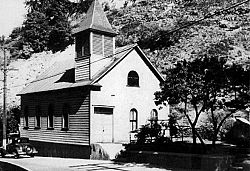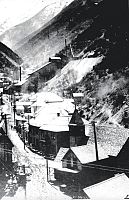Holy Rosary: The parish that got buried
By Gary Topping Archivist, Diocese of Salt Lake City In 1848, when Thomas and Sanford Bingham discovered in the Oquirrh Mountains the canyon that bears their name, they were attracted by its potential for livestock grazing, not realizing the millions of dollars in copper ore that lay beneath their feet. Even after mining began in the canyon, most of it focused on the rich deposits of gold and silver. Only after a railroad was extended to the canyon in 1873 did it become practical to transport the vast quantities of copper ore to processing facilities, and what was to become one of the world’s largest open-pit copper mines was on its way. The late nineteenth century was a great age of immigration, primarily from Europe, but also from Asia, and large numbers of those immigrants found jobs in the copper mine. By 1912 an estimated 65 percent of Bingham miners were foreign-born, and the community became one of the most ethnically diverse populations in the country. Many of those immigrants were Catholics, so the few priests in Salt Lake City, already ministering to far-flung parishes from Ogden in the north to Park City in the east and Silver Reef in the south, now had to find a way to serve Catholics in Bingham Canyon in the west. Although Father Patrick Walsh visited the canyon in 1871, the Catholic population really began to grow after Father (later Bishop) Lawrence Scanlan’s arrival in 1873. Fr. Scanlan celebrated Mass first of all in the Bingham school, but the expanding population of Bingham Catholics outgrew that, and in 1890 a temporary church was erected. Even that proved to be too small, so in 1910 a new parish church was erected in Carr Fork and dedicated to the Holy Rosary. By this time the mine, which was expanding outward as much as downward, was encroaching upon the town itself, and the population began to move outside the canyon. Living conditions in Bingham itself had never been comfortable or safe, with its narrow, crowded streets (it was said that dogs could only wag their tails up and down), frequent fires and landslides. In 1924 Copperfield and Lark became missions of Holy Rosary, as did Copperton in 1935. Some of the work of the Holy Rosary priests was lightened by the Our Lady of Victory Missionary sisters who established a convent in 1941. In 1947 they were succeeded by the Franciscan Sisters of the Atonement. By the late 1940s, though, it became apparent that the mine was going to bury the town, and Bishop Duane G. Hunt began to make plans to relocate the parish to one of the outside communities. With assistance from the Catholic Extension Society, of which our pioneer diocese has been the beneficiary on many occasions, a new church was erected in Copperton. Immaculate Conception Parish was dedicated in 1949. Father John J. Sullivan, the last pastor of Holy Rosary, celebrated the final Mass in the church in 1958 and oversaw the sale of church property to Kennecott Copper pending its destruction. Holy Rosary Parish may have come to an end in 1958, but its legacy is far from dead. In 1969 Catholics in West Jordan, many of whom were former Binghamites, became numerous enough that Bishop Joseph L. Federal created Saint Joseph the Worker Parish. With strong pride in their working class identity and their belief in the dignity of labor, the people of St. Joseph the Worker Parish joined the people of Immaculate Conception Parish in paying tribute to their roots among the immigrant worker Catholics of Bingham Canyon.
© Copyright 2025 The Diocese of Salt Lake City. All rights reserved.



Stay Connected With Us